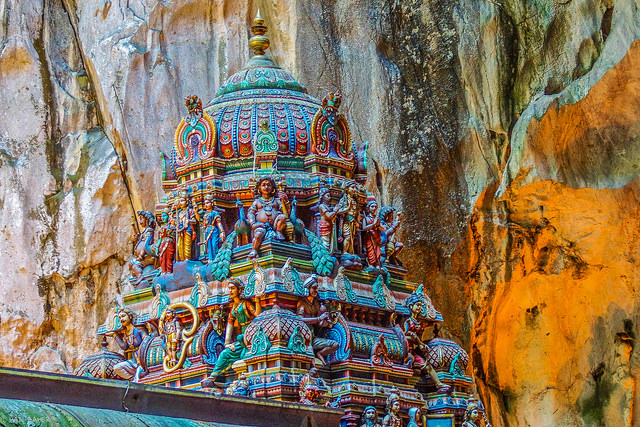
It is a great idea on your part.
You are working with Indians or moving to India, and you want to be prepared. You want to be sensitive. So you start learning about the culture and decide you need to know something about Hinduism. “What is Hinduism?” you ask yourself.
You get online and browse around some websites. You order a book that looks good. Maybe you get really ambitious and try to read the Bhagavad Gita.
You are trying to dip your toe into the shallow end of the pool just to get a feel for what Hinduism is, and how learning about it will help you live and work better with India.
However, if you are like most of us, you will abandon this pretty quickly for one or more reasons:
- The content is way too philosophical. It tries to explain the difference between Vedanta and Mimamsa in the second chapter. It gets too deep too fast, and there is no frame of reference.
- The content is overly spiritualized. Everything seems to be about seeking the inner god in you, being a good person, etc. It strikes you more as “new age” than a multi-millennia religion.
- The content isn’t consistent. If you are comparing what you read from different sources, you notice large gaps and contradictory statements that make no sense when put together.
- It doesn’t match up with what you observe and experience in everyday life. The whole reason you wanted to learn what is Hinduism in the first place is to gain an insight into working with Hindus. However, more than 90% of what you learned is useless in conversation and understanding daily life.
There ends your short journey into learning about Hinduism.
I don’t claim to be an expert on Hinduism, but I think we are approaching it the wrong way. Trying to learn abstractly about Hinduism and then apply those lessons onto individuals will not help you.
We are going to begin a series on Hinduism from an extremely practical approach. These articles will focus only on the concepts associated with Hinduism that really affect the day-to-day lives of Indians. You will walk away not only with good conversation pieces, but a much better understanding of how your Hindu friends and colleagues see the world.
As always, some disclaimers:
- Not all Indians are Hindus. I’ll do my best to only use the word ‘Hindus’ instead of ‘Indians’ where applicable.
- This is for outsiders. This is meant primarily for people with no concept of Hinduism at all. If any Hindus would like to add to the discussion, please do, but remember that we are trying to offer a beneficial starting place to those engaging with India.
- I’m stealing basically all of this stuff. In addition to my own reflections while living in India, a lot of the thoughts you see here come from Understanding Hinduism by Swami Dayanand Bharati, who has graciously allowed me to quote liberally from him. I’ve marked his quotes with “DB”. His book is pretty heady, but has a new edition coming out soon. You could consider these articles as a primer for that book.
- Nothing is absolute in India. Anything I say here can be convincingly refuted by someone else. There are a multitude of opinions and theories about every issue we’ll cover. Everything should have an asterisk by it. Don’t take my word for everything, but use it as a conversation topic when talking with Hindu friends.
DB offers two quotes from historian Chaturvedi Badrinath in Dharma, India and the World Order.
“All single definite statements about Indian culture will, unless they are balanced by their opposites, remain incomplete, and therefore misleading.” (15)
“All statements about the Indian position on the issues governing human life would need to be qualified, even as they were qualified by ancient Indians themselves no sooner than they made them.” (30)
To start, here are the major principles you must accept before you begin looking at the ins and outs of what is Hinduism.
Don’t confuse the 3 components of Religion
As I said in this article, religions are made up of three components:
- Beliefs about the spiritual world
- Practiced behaviors
- A community to which you belong
For example, when someone says they are a Christian, they might mean 1) They believe that Jesus Christ is the Son of God, 2) They go to church every Sunday morning, or 3) They closely identify with a group of people that does these things.
By self-identifying as a particular religion, some people mean only one of these things, some mean two of them, and some mean all three. However, it is important that you recognize a distinct difference among them.
‘Religion’ as defined by the west has mainly only been about beliefs. If you look up Hinduism in a world religion textbook, it will certainly begin telling you what Hindus “believe” about the world.
However, being ‘Hindu’ has always primarily been first about community, second about behaviors, and third about beliefs. When you think of ‘Hinduism’, you think of words like karma, reincarnation, and dharma. When a Hindu thinks of ‘Hinduism’, they think of phrases like pujas for my grandmother, arranged marriages, and no beef. Any practical discussion on Hinduism should only discuss beliefs as much as they affect behaviors and the community.
This is also what Hindus mean when they tell you Hinduism is not a religion, “It is a way of life.” While a cliché, there is a lot of truth in this as it keeps you from focusing only on beliefs.
Hinduism is not like other ‘world religions’
There is no founder of Hinduism.
There are no central teachings.
There is no single authoritative book of truth.
There is no authoritative voice to speak absolutely on Hinduism (aside from a Hindu’s grandparents).
We struggle with this in our western view of religion because we think “the truth about religions is found in sacred books rather than in lived experience.” (DB)
Think of Hinduisms rather than Hinduism
Similar to #IndiasNotIndia, there are many types and kinds of Hinduism out there.
The story is told that the term ‘Hinduism’ was invented as an umbrella term by the British and other Europeans when they attempted to describe the religious nature of India.
So, while other religions like Islam and Christianity started in a single place and created divisions later on, Hinduism stared in multiple places and has over the years joined into one ‘religion’.
Most of the ‘Hinduisms’ you will encounter are either regionally or community-based. If someone from one community visits the festival of another community, it is likely that they will have no clue what is going on. It will be completely foreign to them, even if it looks similar to you as an outsider.
Another distinction of ‘Hinduisms’ is philosophical vs. popular. Philosophical Hinduism is focused on some of the ancient philosophical schools of thoughts that are extremely deep and hard for the Westerner to understand. Popular Hinduism is best seen in groups like Sri Sri Ravi Shankar’s Art of Living campus and others that promote general peace and well-being, loosely tied with different kinds of divinity.
This diversity and synthesis has both allowed Hinduism to survive for so long, and also made it a complete puzzle to outsiders.
DB again quotes Badrinath saying, “There has thus been a double error of identity, first in gathering the diverse faiths, beliefs and practices under a fictitious ‘Hinduism’, then in taking that to be a ‘religion’. This error still persists” (21).
Start with the individual, not the religion
As Swami Dayanand says, “The best way to understand Hinduism is to understand Hindus themselves.”
It is wrong to approach Hinduism from the outside and try to see it as a whole. You will learn nothing if you ask the question, “How does Hinduism affect the lives of Hindus?” Instead, ask the question, “What can I learn about Hinduism from understanding Hindus?”
Hinduism as a whole is more comfortable with loose mystery than tight logical frameworks
There are no clear-cut answers when it comes to Hinduism. DB says, “Hinduism is comfortable with questions, it prefers to leave things unclear rather than present a logical answer.”
No Hindu teaching ever attempts to give the final word on a subject. It is always an ongoing dialogue that is open for interpretation. No one can ever say “this is the complete Hindu response to the afterlife”. (However, when it comes to behaviors such as “the complete Hindu response to arranged marriages”, there is more agreement.)
Most Hindus readily accept the fact that the human mind is incapable of understanding something as vast as God and eternity. They do not pretend to have a complete, airtight understanding of these things.
Because of this, if you look critically at Hindu writings and stories, you will quickly find many contradictions. When you raise these objections, you miss the point. Drawing attention to contradictions and trying to force Hinduism to give clear answers does no one any good.
This was a mistake of scholars in the past. DB says, “the more they advanced in this subject, the more they complicated it.” He then credits Julius Lipner for saying that the works of scholars forced lay people to think of what Hinduism should be instead of understanding it as it is.
Traditional logic doesn’t always apply to Hindu beliefs. If a = b, and b c, a Hindu philosopher might ask “What is preventing a = c?” This does not at all suggest that Hinduism is illogical. Rather, it suggests they approach beliefs from a completely different mindset than others, and don’t give traditional logic the final say.
In future articles, we’ll take these foundational ideas and apply them practically to concepts like dharma, life-cycle rituals, caste, and stages of life. Look forward to being able to understand something new that will actually help you in your interactions with India!
Remember to subscribe for all the latest articles delivered directly to your inbox!
Photo Credit: Hadi Zaher on Flickr




